|
 |
|
 |
|
|
Everyone knows the end result of that
contest in the Elah Valley. Armed with
a sling and a stone, David was the
undisputed champion, while Goliath lost his
head. When the Philistines saw their
champion was dead, they fled for their
lives. Then verse 52 states, "The
troops of Israel and Judah rose up with a
shout and pursued the Philistines as far as
Gath and the gates of Ekron, so that the
wounded Philistines fell on the way from
Shaaraim as far as Gath and Ekron." |
|
|
|
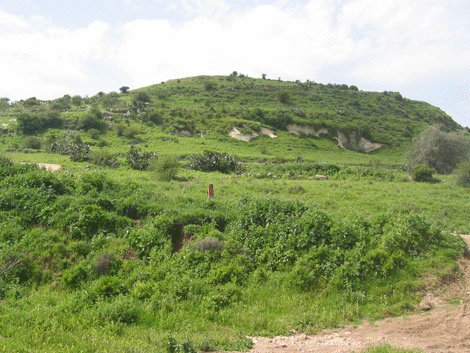 |
|
Photo:
Gila Yudkin |
|
Biblical Gath (Tel es-Safi), Goliath's
hometown |
|
|
|
Since I became a guide over three decades
ago, Ekron and Gath have been identified
without a doubt. But just very
recently, Shaaraim (pronounced shah-are-RYE-yeem)
has been located. Not without a doubt
that will take time until the scholars
hash out the evidence but it's very
likely. |
|
|
|
In the meantime the site is known by its
Arabic name, Khirbet Kheiyafa. (It's
sometimes called in English "Elah
Fortress.") Because of the dating of
its pottery, to the tenth century BC,
Khirbet Kheiyafa has stirred up a lot of
controversy among biblical scholars and
archeologists about the extent of the
kingdom of David. |
|
|
|
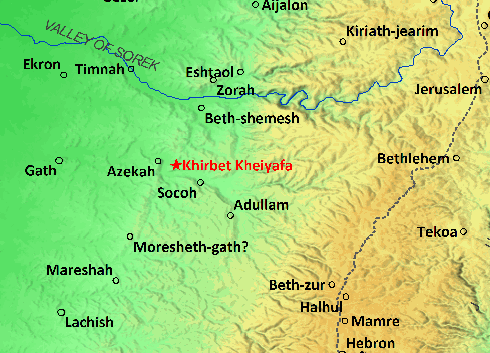 |
|
Copyright
2012 by Gila Yudkin |
|
The Elah Valley runs
between Khirbet Kheiyafa and Azekah, Socoh &
Adullam |
|
|
|
My friend Elie and I had tried to find the
site two years ago while we were also
searching for the Cave of Adullam. (We
found the cave! At least we think we did
)
But Elie's car broke down before we had
finished checking out all our hunches about
where Khirbet Kheiyafa might be.
We decided to try again. While guiding at
the summit of Azekah, the Philistine
stronghold, Elie noticed a path across the
Elah Valley leading up to a ridge with
excavations on top. So early one
Shabbat summer morning we drove in Elie's
wannabe 4 x 4 along a stony dirt road
peppered with home-made signs saying
Khirbet Kheiyafa. |
|
|
|
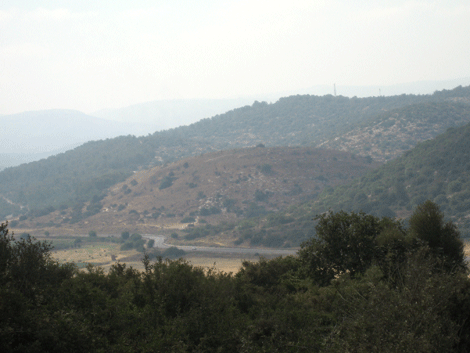 |
|
Photo:
Gila Yudkin |
|
Across from Khirbet
Kheiyafa, the rounded hill in the center is
Socoh |
|
The beginning of the
Hebron Hills can be seen in the distance to
the left |
|
|
|
Neither of us had ever been there, so we
didn't exactly know what to look for where.
All we knew is that Shaaraim means "two
gates" in Hebrew and that the excavator
Yossi Garfinkel claimed to have found two
gates, one in the west and one in the south.
So we took out our new iPhones, tested the
compass feature and voila, we found the two
gates! |
|
|
|
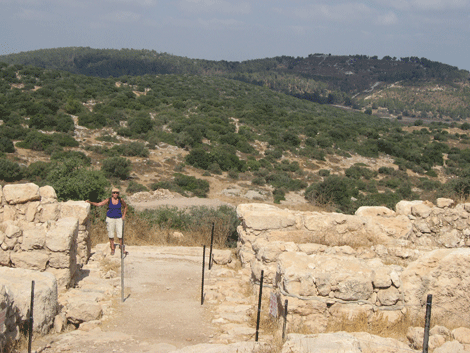 |
|
Photo:
Elie Ben Meir |
|
Western city gate of "Shaaraim"
-- Azekah with the trees is on the right |
|
|
|
The sun got stronger, so we climbed into a
"no entry" antiquities zone for some shade.
We made ourselves comfortable on some
boulders as I read aloud a 12-page article
about Khirbet Kheiyafa I had clipped from a
newspaper. We brainstormed theories
about the scope of David's kingdom and
laughed over some funny comments about the
rivalry between Tel Aviv and Hebrew
University departments of archeology. |
|
|
We realized from the article that we had
missed the newly discovered cultic area
(announced in May 2012 with five standing
stones, two basalt altars, two pottery
libation vessels and two portable shrines).
But we couldn't figure out where that
area was. We knew we'd be back.... |
|
|
|
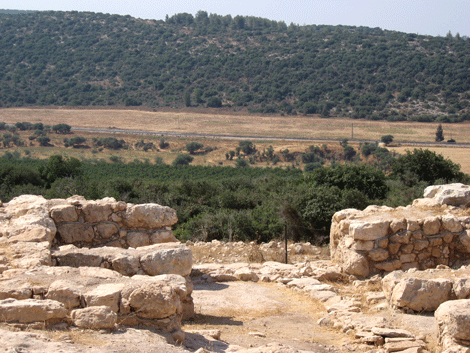 |
|
Photo:
Gila Yudkin |
|
Southern city gate of "Shaaraim"
-- the Elah Valley sits below |
|
|
|
It was time to go and just as we finished
climbing over the fence out of the "no
entry" area, we were startled to encounter a
group of very nicely dressed elderly
Israelis. (Some of the guys were even
wearing white button down shirts in this
super dusty place!). They had a guide
and Elie and I spontaneously decided to join
the tour. (Now when I'm guiding, I
call people who join without permission
'infiltrators'!) |
|
|
|
Well, the guide was none other than the
chief excavator himself, Yossi Garfinkel.
He led the group to the western gate and as
he stood in the tenth century BC threshold,
he recounted the story of David coming down
from Bethlehem armed with dried grain, ten
loaves and some cheeses. I had always
thought that this detail meant that all the
fighters were responsible for providing
their own supplies which hints at the fact
that Saul's army was not that well organized
or efficient in terms of logistics. |
|
|
But Yossi noted that the cheeses were meant
for the officers commanding David's older
brothers. It's in the text, but I had
missed it during my hundreds of readings.
I found myself wondering what it meant --
would these cheeses give the brothers better
weapons, a better position in the battle
line-up, or better sleeping accommodations
on the hard rocky ground? |
|
|
As we looked down into the valley below,
Yossi said, "This city is the sentry of the
kingdom of Judah. The Elah Valley is
the route that leads from the coastal plain
to the hill region. On one side, in
the plain, you have the five Philistine
cities and on the other side, to the east,
the kingdom of Judah is taking shape." |
|
|
 |
|
Photo:
Gila Yudkin |
|
Archeologist Garfinkel
estimates 500 to 600 people lived in the
city |
|
Yossi went on to discuss the evidence that
the site was Israelite. He pointed out
the casemate (double) wall which is similar
to the casemate wall of Israelite Beersheba
and mentioned the fact that no pig bones
were found at the site. (The
Philistines were known to gorge themselves
on ham sandwiches and pork chops. Only
partially kidding the Philistines did
indeed eat pork, whereas the Israelites and
Canaanites
did not.) |
|
|
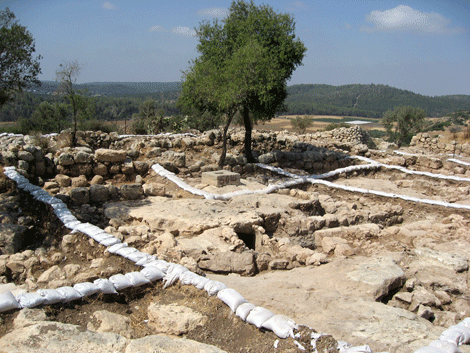 |
|
Photo:
Gila Yudkin |
|
Excavations at Khirbet
Kheiyafa (Shaaraim?) at the end of the 2012
season |
|
|
Another intriguing Khirbet Kheiyafa
controversy rages around an inscribed
ostracon (potsherd) found by Yossi and his
team at the site. They claim it's the
oldest Hebrew inscription found until now.
Not all scholars agree. Stay tuned. |
|
|
|
if Khirbet Kheiyafa is indeed proved to be
Shaaraim, then we have a vital clue pointing
to the true site of David's battle against
Goliath. Come with me to the Elah
Valley and you will see with your own eyes! |
|
|
|
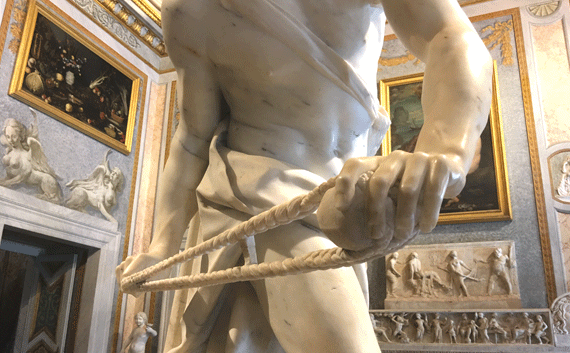 |
|
Photo: Gila
Yudkin |
|
Bernini's David in
Galleria Borghese with David about to kill
Goliath |
|
|
| |
|
Postscript |
| |
| In December
2020 a friend and I planned to revisit
Shaaraim / Khirbet Kheiyafa to see if we
could find the turn-off, check out the road
leading to the site and see what's
happening. This time we had the
aid of a Google satellite map and Waze.
It was raining in Jerusalem when we met, but
we decided, "Hey let's go for it." We
had already postponed twice because of the
weather. To our surprise, when we
reached the Valley of Elah, the weather was
glorious! |
| |
| Now there is
a dirt road (with lots of speed bumps shaped
like sand mounds) leading a kilometer and a
half up to the parking lot. It's
accessible to jeeps, but definitely not for
buses. Then it's just a short hike up
to the first of the two gates, the western
gate. |
| |
|
 |
|
Photo:
Silvia Hess |
|
Standing at the western
gate entrance to Shaaraim with Tel Azekah
behind |
| |
|
 |
|
Photo:
Silvia Hess |
|
Inside the partly restored
inner gate of Shaaraim |
| |
|
 |
|
Photo: Gila
Yudkin |
|
The Elah Valley is the
grassy area beyond the ruins of Shaaraim |
| |
|
 |
|
Photo: Gila
Yudkin |
|
Imagine the wounded
Philistines below the Southern Gate of Shaaraim
in the valley |
| |
|
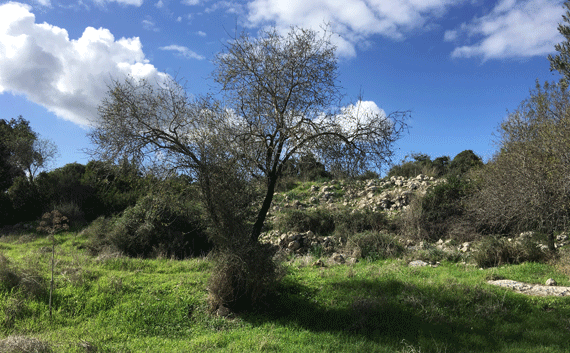 |
|
Photo: Gila
Yudkin December 2020 |
|
A glorious day at Khirbet
Kheiyafa / Shaaraim |
| |
|
12 MOST
POPULAR ARTICLES this month |
| |
|
Gila
Yudkin calls herself a
Connecticut Yankee living in King David's
court. For over three decades she has
been reenacting David's contest with Goliath
when visiting the Elah Valley with her
groups. She even divides the group
into Israelites and Philistines with each
team creating its own war chant. Her
tours are a mix of archeology, geography,
Bible and fun. |
|
|
|
Late 19th century explorers Bliss and
Macalister didn't have iPhones for compass
directions, weather reports or breaking
news, but they did identify Philistine
strongholds of
Azekah and
Gath. Read more about them. |
|
|
|
Not everyone who visits the holy land has
the time to make an excursion to the Elah
Valley. And only a fraction of those
who do, ever come close to the authentic
battlefield. If this is your heart's
desire, then
book Gila for your
next holy land tour! |
| |
|
Copyright 2012, 2020 Gila Yudkin. Permission
needed for any reuse. |
| |
| More on
archeology and the Biblical narrative: |
| |
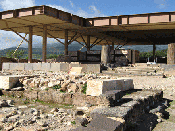 |
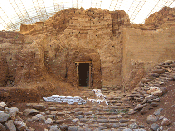 |
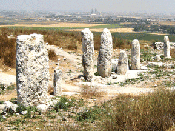 |
|
Joshua / Hazor |
Abraham / Dan |
Solomon's
dowry / Gezer |
|
|
|

